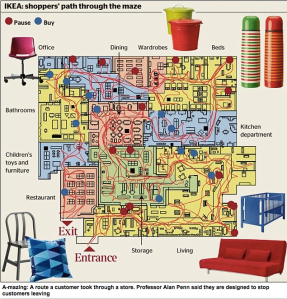In August 1962 the Kent State Summer News reported a campus wide landscaping program that was concreting paths worn by social short cuts taken by students. This was the resolution of a long-run difference in understanding and using the university campus, between students seeking the shortest routes between buildings, and the superintendent of grounds, the beautifully named Mr Wooddell. Mr Wooddell had first retaliated against the appearance of desire lines by planting thorny bushes and then, when this effort was defeated, the university spent the summer laying concrete paths and stairs to “replace mud paths made by students”.
How much time does the mathematically-inclined student save by taking shortcuts? Four minutes an entire day, one aesthetic student researcher estimated, is the total time saved by the student who uses paths instead of regular walks. “We have tried to put walks in places convenient to students, yet enhancing to the natural beauty of the campus,” said Wooddell. “But new shortcuts are continually developing.”
Source (html)
—–
See Portage, The Ikea Shortcut and the Tactic of the Shortcut
